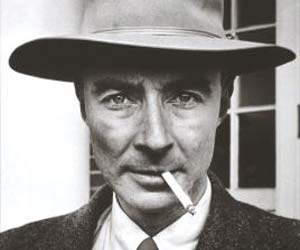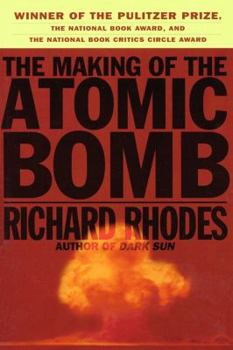Making of the Atomic Bomb
Select Format
Select Condition 
Book Overview
The definitive history of nuclear weapons and the Manhattan Project. From the turn-of-the-century discovery of nuclear energy to the dropping of the first bombs on Japan, Richard Rhodes's Pulitzer... This description may be from another edition of this product.
Format:Paperback
Language:English
ISBN:0684813785
ISBN13:9780684813783
Release Date:August 1995
Publisher:Simon & Schuster
Length:896 Pages
Weight:2.59 lbs.
Dimensions:1.7" x 6.1" x 9.2"
Related Subjects
20th Century Americas Atomic & Nuclear Physics Engineering History History & Philosophy Humanities Military Military Science Military Sciences Modern (16th-21st Centuries) Nuclear Nuclear Physics Science Science & Math Science & Scientists Science & Technology Social Sciences Technology Textbooks Weapons & Warfare WorldCustomer Reviews
5 ratings
The making of the Atomic Bomb is one of the best histories of the era that I have read.
Published by Dale Dewar , 2 months ago
The book covers the entirety of bomb-making, from the discovery of ionizing radiation to the delivery of the bombs - Trinity, Hiroshima and Nagasaki. Anyone interested in any portion of this history should read the book. Warning: it is lengthy but you won't want to put it down!
A brilliant epic retelling of the birth of the atomic bomb
Published by Thriftbooks.com User , 20 years ago
Richard Rhodes's masterpiece is one those books that is almost impossible to over praise. Since reading it a number of years ago, I have been amazed how many times I have heard about one individual or another mentioned in these pages, and either remember specific things about them from this book, or the greater background in which they worked. The book is not, it must be emphasized, not about the Manhattan Project, although that features as a significant feature in the story. Rhodes's tale begins well in advance of that, and his narrative for several hundred pages is a story of the men and women who first started thinking within the field of physics that would eventually make the atomic bomb a theoretical possibility. The cast of characters is immense, and involves nearly all of the major theoretical physicists of the first half of the twentieth century (though many would continue to dominate well into the 20th--indeed, one of the major players, Edward Teller, died only a few weeks before my writing this review). The first part of the book deals with those men and women who did made a series of brilliant breakthroughs in physics that made the building of an atomic bomb not merely conceivable but feasible, at least sufficiently feasible for the major players in WW II to explore in a full-fledged way whether an atomic bomb could be built. The second half of the book details the efforts of the major players in WW II to build such a bomb. I found this especially interesting, because often writers mention the danger of Hitler having built an atomic bomb before the allies, but Rhodes pretty much destroys any illusions about this. He shows that, first, the German atomic program was tremendously under funded and given only a modicum of support by Hitler and his advisors. There were two major reasons for this. First, the Nazis had little or no access to the materials that would make such a program successful, in particular to an unstable uranium isotope. Their lone source lay in heavy water, which they were able to get from Sweden, but it is exceedingly doubtful that they would have had enough to produce sufficient material for a bomb even if they had known how to do so. But the greater impediment to the building of a bomb was Hitler's own disinclination to do so. Partly because of his own experience with mustard gas in WW I, Hitler was personally opposed to the use of what we would today call WMDs. But as Rhodes shows, even in America there was uncertainty about how devastating such a weapon would be, and some of the Nazis felt that the bomb would result in setting the earth's atmosphere on fire. Therefore, the German atomic threat is greatly exaggerated. Yet, it is still asserted. I read just recently a book by former MP and cabinet minister Roy Jenkins, in which he discusses the possibility of the Nazis getting the bomb first in WW II, an event that is at most a remote possibility. In addition to the German program, Rhodes also discus
absolutely first rate scientific and political history
Published by Thriftbooks.com User , 22 years ago
This is one of those books that has it all: fascinating personalities, fundamental scientific discoveries explained with utter clarity, and the birth of political issues that are as relevant today as they were 60 years ago. That it is almost certainly the best book on the development of the atomic bomb is in itself remarkable, as the field is already crowded with mediocre efforts. Rhodes makes an entire era - the first half of the 20th Century - come alive in exacting detail. THe book starts with a ruminating Leo Szilard as he wanders the streets of London, with the concept of an atom bomb germinating in his mind. His pesonality is so quirky, his propensity to find just the right contact to advance his agenda, make him the ideal vehicle to follow the story of the harnessing of the atom for military purpose. But to offer a full view, Rhodes starts with the Curies and their milieu, when they discovered radiation - a fundamental new form of energy that could not be explained by chemistry - that was the start of the 20C revolution in physics. Not only does this story cover such luminaries as Einstein and Bohr, but it includes many others lesser known, who added their discoveries to the pieces of the puzzle that finally elucidated the structure of the atom. These developments are also brilliantly set in European and American history, where the rise of Nazism renders them frighteningly relevant. In addition, other issues are addressed, such as the reason for the sudden blossomng of several Hungarian geniuses, including Szilard and von Neumann, who left their homeland for the US.Then Rhodes moves to the practical question of the Bomb's development, which was accomplished predominently by European scientists in exile and some remarkable Americans as well. Here, you witness Enrico Fermi as he creates the first self-sustaining nuclear reaction in CHicago; the flowering of Oppenheimer's genius for administration; and the efforts that Heisenburg led, and perhaps sabotaged, in Nazi Germany. Each personality is given the depth you would expect in a historical novel with adventure, such as Bohr's flight from Norway, and the infighting that went on behind the scenes. It is simply a masterpiece of historical reporting.Though his output has covered many topics, from his personal sexual history to hard scientific topics, Rhodes is indisputably one of America's greatest writers. I was fascinated by this book from page one and even took vacation time so that I could read it in peace while my daughter was in school.Highest recommendation.
This Changes Everything
Published by Thriftbooks.com User , 23 years ago
I will echo the other reviewers: this is one of the best, if not the best book I have read.The book covers the subect on a number of levels. First is the factual story of the events leading up to the making of the bomb, which in themselves would be fascinating. For example, the fact that in two years the Manhattan Project built an industrial plant larger than the US automobile manufacturing base. That only in December of 1938 was the fission of Uranium first discovered, but the course of events were so rapid as to lead to the Trinity test in July of 1945. As a sometime program manager, but no General Groves, it was a fascinating account of the world's most significant projecct.The second level is a very enjoyable history of nuclear physics as the reader is lead through the discovery process from the turn of the century to thermonuclear fusion. That discovery process is the vehicle for the third and fourth levels of the book. The stories and personalities of the scientists, around the world, who added to that knowledge, what shaped and motivated their lives and how they indiviually gained insight, brilliant insight, into the riddle that was physics. I felt I got to know people like Rutherford, Bohr, Oppenheimer, Fermi, Szilard, and Teller. The fourth level was that the insight was not really individual but collaborative. This book is one of the finest descriptions of the scientific process and how this open, collaborative and communicative process works across boundaries.The last level, the biggest surprise and the most profoundly unsettling, was the realization of how this event, inevitable, has "changed everything" about human history - an appreciation, I believe 55 years later, we who did not participate in the Manhattan Project, have yet to fully realize. Niels Bohr realized it in an instant. The book is superbly written. The personalies came alive, I felt I knew Niels Bohr. It was absolutely suspenseful even though you know the ending (you don't really). I was caught up in the story as though it were a novel. After reading late the night before, one evening I came home and declared to my wife "They dropped the bomb!". Such was the intensity of my participation in the book that my voice had excitement to it. She was horrified. I had to explain, "No, no. In the book. On Hiroshima". When history is that exciting it is hard to beat.This is one of only a few books about which I can say that I will never quite view the world the same again.A masterpiece and a must read.
required reading - AND utterly captivating
Published by Thriftbooks.com User , 24 years ago
Everyone seeking to understand the 20th century, its history, its politics, its scientific development, must read this book. Not only does it illuminate one of the foundational events of our time far better than any other source, it definitively sets forth modern science, its ethical dilemmas, its odd combination of unbelievable explanatory power and the utterly (humanly) unfathomable reality science suggests. Rhodes traces the development of the atomic bomb to its scientific roots, which he demonstrates are inextricably intertwined with the people pushing the scientific developments at an ever increasing speed and for a long time had no idea of the potential their theories carried. Rhodes manages to do all this with complete lucidity, allowing the reader totally unfamiliar with quantum mechanics to follow along with reasonable comprehension. At the same time, the psychological, ethical and political dramas Rhodes describes make this the hands-down most thrilling, most exciting book I have ever read
The Making of the Atomic Bomb Mentions in Our Blog

Oppenheimer Reading List
Published by Ashly Moore Sheldon • July 27, 2023
Featuring a glittering, star-studded cast, Christopher Nolan's brilliant new film charts the turbulent life of J. Robert Oppenheimer, the theoretical physicist who played a significant role in developing the first atomic bombs. If you enjoyed the movie, here's your chance to learn more about this fascinating chapter from history.

National Bikini Day: How Four Little Triangles of Fabric Changed the World
Published by Beth Clark • July 05, 2018
On July 5, 1946, the bikini debuted and forever altered swimwear so dramatically that the ripples are still being felt 72 years later!





